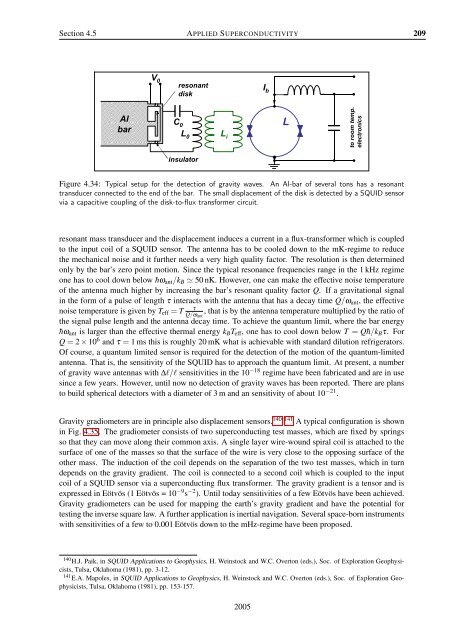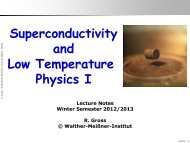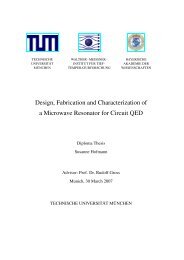Applied Superconductivity - Walther Meißner Institut - Bayerische ...
Applied Superconductivity - Walther Meißner Institut - Bayerische ...
Applied Superconductivity - Walther Meißner Institut - Bayerische ...
- No tags were found...
Create successful ePaper yourself
Turn your PDF publications into a flip-book with our unique Google optimized e-Paper software.
Section 4.5 APPLIED SUPERCONDUCTIVITY 209V 0L iLresonantdiskI bAlbarC 0L 0insulatorto room temp.electronicsFigure 4.34: Typical setup for the detection of gravity waves. An Al-bar of several tons has a resonanttransducer connected to the end of the bar. The small displacement of the disk is detected by a SQUID sensorvia a capacitive coupling of the disk-to-flux transformer circuit.resonant mass transducer and the displacement induces a current in a flux-transformer which is coupledto the input coil of a SQUID sensor. The antenna has to be cooled down to the mK-regime to reducethe mechanical noise and it further needs a very high quality factor. The resolution is then determinedonly by the bar’s zero point motion. Since the typical resonance frequencies range in the 1 kHz regimeone has to cool down below ¯hω ant /k B ≃ 50 nK. However, one can make the effective noise temperatureof the antenna much higher by increasing the bar’s resonant quality factor Q. If a gravitational signalin the form of a pulse of length τ interacts with the antenna that has a decay time Q/ω ant , the effectivenoise temperature is given by T eff = TτQ/ω ant, that is by the antenna temperature multiplied by the ratio ofthe signal pulse length and the antenna decay time. To achieve the quantum limit, where the bar energy¯hω ant is larger than the effective thermal energy k B T eff , one has to cool down below T = Q¯h/k B τ. ForQ = 2 × 10 6 and τ = 1 ms this is roughly 20 mK what is achievable with standard dilution refrigerators.Of course, a quantum limited sensor is required for the detection of the motion of the quantum-limitedantenna. That is, the sensitivity of the SQUID has to approach the quantum limit. At present, a numberof gravity wave antennas with ∆l/l sensitivities in the 10 −18 regime have been fabricated and are in usesince a few years. However, until now no detection of gravity waves has been reported. There are plansto build spherical detectors with a diameter of 3 m and an sensitivity of about 10 −21 .Gravity gradiometers are in principle also displacement sensors. 140,141 A typical configuration is shownin Fig. 4.35. The gradiometer consists of two superconducting test masses, which are fixed by springsso that they can move along their common axis. A single layer wire-wound spiral coil is attached to thesurface of one of the masses so that the surface of the wire is very close to the opposing surface of theother mass. The induction of the coil depends on the separation of the two test masses, which in turndepends on the gravity gradient. The coil is connected to a second coil which is coupled to the inputcoil of a SQUID sensor via a superconducting flux transformer. The gravity gradient is a tensor and isexpressed in Eötvös (1 Eötvös = 10 −9 s −2 ). Until today sensitivities of a few Eötvös have been achieved.Gravity gradiometers can be used for mapping the earth’s gravity gradient and have the potential fortesting the inverse square law. A further application is inertial navigation. Several space-born instrumentswith sensitivities of a few to 0.001 Eötvös down to the mHz-regime have been proposed.140 H.J. Paik, in SQUID Applications to Geophysics, H. Weinstock and W.C. Overton (eds.), Soc. of Exploration Geophysicists,Tulsa, Oklahoma (1981), pp. 3-12.141 E.A. Mapoles, in SQUID Applications to Geophysics, H. Weinstock and W.C. Overton (eds.), Soc. of Exploration Geophysicists,Tulsa, Oklahoma (1981), pp. 153-157.2005
















